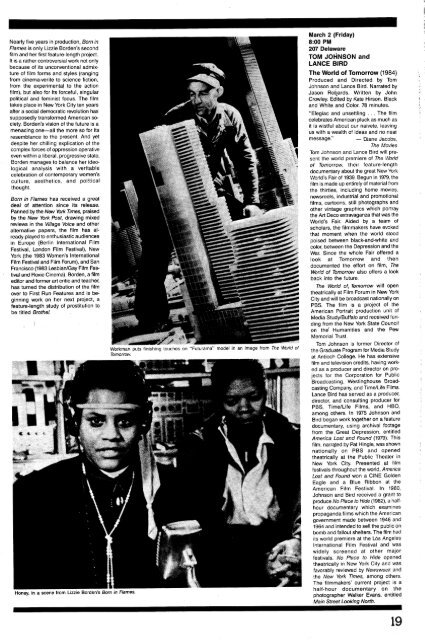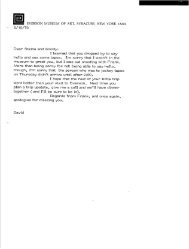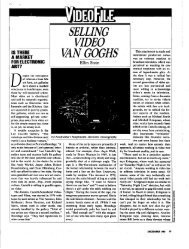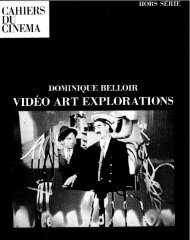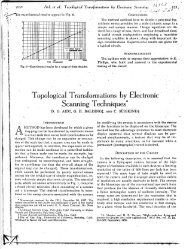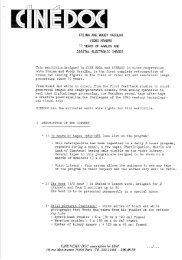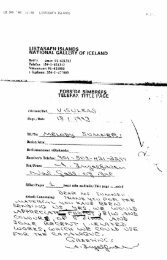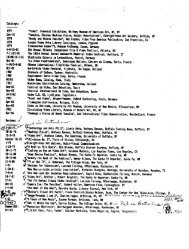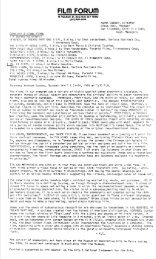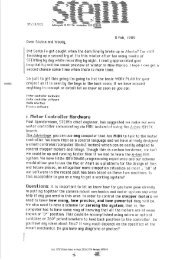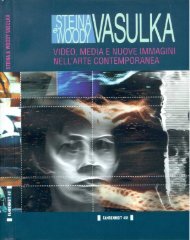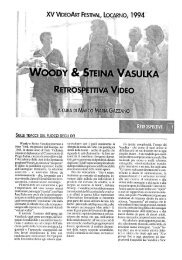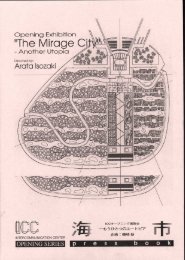MEDIA STUDY/BUFFALO - the Vasulkas
MEDIA STUDY/BUFFALO - the Vasulkas
MEDIA STUDY/BUFFALO - the Vasulkas
Create successful ePaper yourself
Turn your PDF publications into a flip-book with our unique Google optimized e-Paper software.
Nearly five years in production, Born in<br />
Flames is only Lizzie Borden's second<br />
film and her first feature-length project .<br />
It is a ra<strong>the</strong>r controversial work not only<br />
because of its unconventional admixture<br />
of film forms and styles (ranging<br />
from cinema-verite to science fiction,<br />
from <strong>the</strong> experimental to <strong>the</strong> action<br />
film), but also for its forceful, singular<br />
political and feminist focus . The film<br />
takes place in New York City ten years<br />
after a social democratic revolution has<br />
supposedly transformed American society.<br />
Borden's vision of <strong>the</strong> future is a<br />
menacing one-all <strong>the</strong> more so for its<br />
resemblance to <strong>the</strong> present . And yet<br />
despite her chilling explication of <strong>the</strong><br />
complex forces of oppression operative<br />
even within a liberal, progressive state,<br />
Borden manages to balance her ideological<br />
analysis with a veritable<br />
celebration of contemporary women's<br />
culture, aes<strong>the</strong>tics, and political<br />
thought .<br />
Born in Flames has received a great<br />
deal of attention since its release .<br />
Panned by <strong>the</strong> New York Times, praised<br />
by <strong>the</strong> New York Post, drawing mixed<br />
reviews in <strong>the</strong> Village Voice and o<strong>the</strong>r<br />
alternative papers, <strong>the</strong> film has already<br />
played to enthusiastic audiences<br />
in Europe (Berlin International Film<br />
Festival, London Film Festival), New<br />
York (<strong>the</strong> 1983 Women's International<br />
Film Festival and Film Forum), and San<br />
Francisco (1983 Lesbian/Gay Film Festival<br />
and Roxie Cinema) . Borden, a film<br />
editor and former art critic and teacher,<br />
has turned <strong>the</strong> distribution of <strong>the</strong> film<br />
over to First Run Features and is beginning<br />
work on her next project, a<br />
feature-length study of prostitution to<br />
be titled Bro<strong>the</strong>l.<br />
Honey, in a scene from Lizzie Borden's Born in Flames.<br />
Workman puts finishing touches on "Futurama" model in an image from The World of<br />
Tomorrow.<br />
March 2 (Friday)<br />
8 :00 PM<br />
207 Delaware<br />
TOM J014NSON and<br />
LANCE BIRD<br />
The World of Tomorrow (1984)<br />
Produced and Directed by Tom<br />
Johnson and Lance Bird . Narrated by<br />
Jason Robards . Written by John<br />
Crowley. Edited by Kate Hirson . Black<br />
and White and Color. 78 minutes .<br />
"Elegiac and unsettling . . . The film<br />
celebrates American pluck as much as<br />
it is wistful about our naivete, leaving<br />
us with a wealth of ideas and no neat<br />
message ." - Diane Jacobs,<br />
The Movies<br />
Tom Johnson and Lance Bird will present<br />
<strong>the</strong> world premiere of The World<br />
of Tomorrow, <strong>the</strong>ir feature-length<br />
documentary about <strong>the</strong> great New York<br />
World's Fair of 1939 . Begun in 1979, <strong>the</strong><br />
film is made up entirely of material from<br />
<strong>the</strong> thirties, including home movies,<br />
newsreels, industrial and promotional<br />
films, cartoons, still photographs and<br />
o<strong>the</strong>r vintage graphics which portray<br />
<strong>the</strong> Art Deco extravaganza that was <strong>the</strong><br />
World's Fair. Aided by a team of<br />
scholars, <strong>the</strong> filmmakers have evoked<br />
that moment when <strong>the</strong> world stood<br />
poised between black-and-white and<br />
color, between <strong>the</strong> Depression and <strong>the</strong><br />
War. Since <strong>the</strong> whole Fair offered a<br />
look at Tomorrow and <strong>the</strong>n<br />
documented <strong>the</strong> effort on film, The<br />
World of Tomorrow also offers a look<br />
back into <strong>the</strong> future.<br />
The World of., Tomorrow will open<br />
<strong>the</strong>atrically at Film Forum in New York<br />
City and will be broadcast nationally on<br />
PBS . The film is a project of <strong>the</strong><br />
American Portrait production unit of<br />
Media Study/Buffalo and received funding<br />
from <strong>the</strong> New York State Council<br />
on <strong>the</strong>' Humanities and <strong>the</strong> Pew<br />
Memorial Trust .<br />
Tom Johnson is former Director of<br />
<strong>the</strong> Graduate Program for Media Study<br />
at Antioch College. He has extensive<br />
film and television credits, having worked<br />
as a producer and director on projects<br />
for <strong>the</strong> Corporation for Public<br />
Broadcasting, Westinghouse Broadcasting<br />
Company, and Time/Life Films .<br />
Lance Bird has served as a producer,<br />
director, and consulting producer for<br />
PBS, Time/Life Films, and HBO,<br />
among o<strong>the</strong>rs . In 1975 Johnson and<br />
Bird began work toge<strong>the</strong>r on a feature<br />
documentary, using archival footage<br />
from <strong>the</strong>,Great Depression, entitled<br />
America Lost and Found (1979) . This<br />
film, narrated by Pat Hingle, was shown<br />
nationally on PBS and opened<br />
<strong>the</strong>atrically at <strong>the</strong> Public Theater in<br />
New York City. Presented at film<br />
festivals throughout <strong>the</strong> world, America<br />
Lost and Found won a CINE Golden<br />
Eagle and a Blue Ribbon at <strong>the</strong><br />
American Film Festival . In 1980,<br />
Johnson and Bird received a grant to<br />
produce No Place to Hide (1982), a halfhour<br />
documentary which examines<br />
propaganda films which <strong>the</strong> American<br />
government made between 1946 and<br />
1964 and intended to sell <strong>the</strong> public on<br />
bomb and fallout shelters . The film had<br />
its world premiere at <strong>the</strong> Los Angeles<br />
International Film Festival and was<br />
widely screened at o<strong>the</strong>r major<br />
festivals . No Place to Hide opened<br />
<strong>the</strong>atrically in New York City and was<br />
favorably reviewed by Newsweek and<br />
<strong>the</strong> New York Times, among o<strong>the</strong>rs .<br />
The filmmakers' current project is a<br />
half-hour documentary on <strong>the</strong><br />
photographer Walker Evans, entitled<br />
Main Street Looking North .<br />
19


